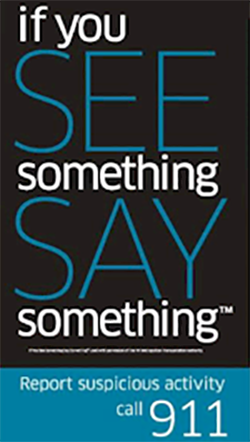Active Shooter Training
Shots fired is the last thing you'd expect to hear on campus. While the possibility of being involved in an active shooter incident on campus may be remote, the consequences can be catastrophic. That's why it makes good sense to spend some time now thinking and preparing for it. The University of Oklahoma Police Department has specialized instructors that prepare students, faculty, and staff to have a survival mindset for such an incident. They further train the community in how law enforcement will respond to an active shooting situation and what pre-incident behaviors of concern are.
RUN – HIDE – FIGHT
Run
If it is safe to do so, the first course of action that should be taken, is to run out of the building and move far away until you are in a safe location. Faculty, staff and students will be trained to:
- Leave personal belongings behind;
- Visualize possible escape routes, including physically accessible routes for faculty, staff and students with disabilities and others with access and functional needs;
- Avoid escalators and elevators;
- Take others with them but not to stay behind because others will not go;
- Call 911 when safe to do so
Hide
If you find that you cannot get away from the shooter by exiting the structure, you must now move to deny the shooter unfettered access to you and those around you. In addition:
- Lock the doors;
- Barricade the doors with heavy furniture;
- Close and lock windows, and close blinds or cover windows;
- Turn off lights;
- Silence all electronic devices;
- Remain silent;
- Use strategies to silently communicate with first responders if possible, (e.g., in rooms with exterior windows make signs to silently signal law enforcement and emergency responders to indicate the status of the room’s occupants);
- Hide along the wall closest to the exit but out of the view from the hallway (allowing for an ambush of the shooter and for possible escape if the shooter enters the room);
- Remain in place until given an ALL CLEAR by identifiable law enforcement.
Fight
If neither your attempt to avoid or deny access has succeeded, as a last resort when confronted by the shooter, adults in immediate danger should consider trying to disrupt or incapacitate the shooter by using aggressive force and items in their environment, such as fire extinguishers, chairs, etc. In a study of 41 active shooter events that ended before law enforcement arrived, the potential victims stopped the attacker themselves in 16 instances. In 13 of those cases, they physically subdued the attacker.
While talking to faculty, staff and students about confronting a shooter may be daunting and upsetting for some, they must know that they may be able to successfully take action to save lives. To be clear, with the exception of campus law enforcement, confronting an active shooter is never a requirement of any campus employee’s job; how each individual chooses to respond if directly confronted by an active shooter is up to him or her.
Interacting with First Responders
Faculty, staff and students will be trained to understand and expect that law enforcement’s first priority must be to locate and stop the person or persons believed to be the shooter(s); all other actions are secondary. Faculty, staff and students will be trained to cooperate and not to interfere with first responders. When law enforcement arrives, faculty, staff and students must display empty hands with open palms. Law enforcement may instruct everyone to place their hands on their heads, or they may search individuals.
We will teach you in the Law Enforcement Response portion the following:
- The reaction of law enforcement responders
- What information the responding law enforcement responders need
- The distinctions between an active shooter and a hostage-taker
- Describe pre-incident behaviors of concern
- Describe preventive measures to avert violence
If you and your department or group would like a presentation contact LT Brooks at 405-325-8868.


